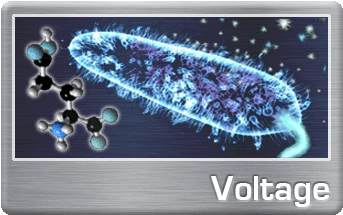Team:Cambridge/Voltage
From 2008.igem.org
| Line 26: | Line 26: | ||
The idea of being able to measure a change in voltage of the medium brings with it a number of challenges. The number of ions flowing across the membrane should be as high as possible, to produce a signal significantly higher than the noise. This could be achieved by first packing the cells with potassium, so that a large gradient was set up between the inside and the outside of the cell. Then when the GluR0 channels open, potassium ions will suddenly flow down the concentration gradient. In order to build up this gradient in the first place, we planned to over-express the Kdp-ATPase, which would pump potassium into the cell. However, to stop the balance being restored, the potassium channels would need to be absent or disabled. | The idea of being able to measure a change in voltage of the medium brings with it a number of challenges. The number of ions flowing across the membrane should be as high as possible, to produce a signal significantly higher than the noise. This could be achieved by first packing the cells with potassium, so that a large gradient was set up between the inside and the outside of the cell. Then when the GluR0 channels open, potassium ions will suddenly flow down the concentration gradient. In order to build up this gradient in the first place, we planned to over-express the Kdp-ATPase, which would pump potassium into the cell. However, to stop the balance being restored, the potassium channels would need to be absent or disabled. | ||
| - | We ordered a variety of mutant E.coli strains | + | We ordered a variety of [[IGEM:Cambridge/2008/Notebook/Voltage/Mutant Strains |mutant E.coli strains]] with mutations in each of the genes coding for the potassium flux membrane proteins Kdp, Kch and Kef. To examine the behaviour of these mutant strains we grew them in a variety of potassium concentrations and used [[IGEM:Cambridge/2008/Notebook/Voltage/OD600 Calibration| OD600 readings]] to measure their [[IGEM:Cambridge/2008/Notebook/Voltage/K+ Growth|growth rates]]. We also measured [[IGEM:Cambridge/2008/Notebook/Voltage/K+ Concentrations| internal potassium concentrations]] using [[IGEM:Cambridge/2008/Notebook/Voltage/Flame Photometer Calibration|flame photometry]]. Unfortunately there was little difference seen between most of the mutants and the control strain, and flame photometry readings were not always reliable. |
We used PCR to copy the Kdp sequence from the E.coli MG1655 genome (link). As the pump is an ATPase, we did not want it to be expressed during exponential phase as it could stunt growth. We therefore also used PCR to extract the osmY promoter (link) from Biobricks developed by MIT in 2006. It is a stationary phase promoter, so by putting Kdp under its control, we could postpone its expression until the cells have stopped needing ATP for growth and division. | We used PCR to copy the Kdp sequence from the E.coli MG1655 genome (link). As the pump is an ATPase, we did not want it to be expressed during exponential phase as it could stunt growth. We therefore also used PCR to extract the osmY promoter (link) from Biobricks developed by MIT in 2006. It is a stationary phase promoter, so by putting Kdp under its control, we could postpone its expression until the cells have stopped needing ATP for growth and division. | ||
| Line 44: | Line 44: | ||
| - | |||
| - | |||
| - | + | ||
| + | |||
Revision as of 21:39, 28 October 2008
|
||
 "
"
